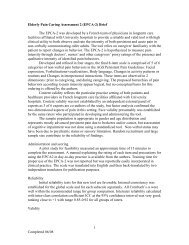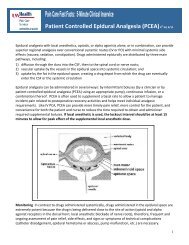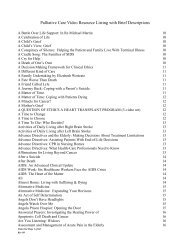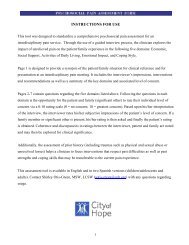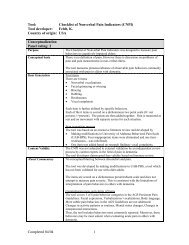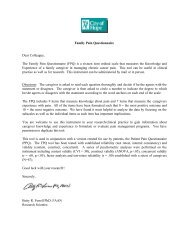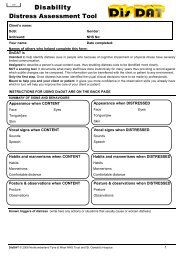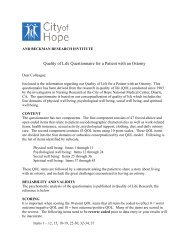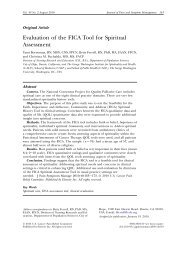Pain Assessment in Advanced Dementia - Pain Resource Center
Pain Assessment in Advanced Dementia - Pain Resource Center
Pain Assessment in Advanced Dementia - Pain Resource Center
Create successful ePaper yourself
Turn your PDF publications into a flip-book with our unique Google optimized e-Paper software.
Scor<strong>in</strong>g procedures are clearly described.No guide to <strong>in</strong>terpretation of tool score is provided. The tool developers arguethat cl<strong>in</strong>icians are familiar with a 0-10 scale and that it is assumed that 0means no observed pa<strong>in</strong> and 10 means a high level of observed pa<strong>in</strong> thatshould be treated.However, this assumes that judg<strong>in</strong>g severity of pa<strong>in</strong> represented by behavioralpresentation <strong>in</strong> non-verbal elders is valid—which has not been substantiated<strong>in</strong> the literature.Subsequent studies have demonstrated strong cl<strong>in</strong>ical utility withadm<strong>in</strong>istration possible with<strong>in</strong> 1-3 m<strong>in</strong>utes, limited tra<strong>in</strong><strong>in</strong>g required(m<strong>in</strong>imum of 15 m<strong>in</strong>utes to 2 hours), and reported ease of use by raters.ReliabilityPanel rat<strong>in</strong>g: 1Revised: 3Internal consistency Study 1 & 2 (Warden et al, 2003; Lane et al., 2003)Internal consistency was evaluated based on data from a sample of 19veterans and QI data from 25 residents. (For sample characteristics seesubjects above).Raters were 4 professional nurses with experience on dementia special careunits and a master’s level social work <strong>in</strong>tern. Three observations of subjectsfor 5 m<strong>in</strong>utes were made under different conditions as <strong>in</strong>dicated below. Toachieve 10 participants per item, the research and QI data were pooled andexam<strong>in</strong>ed for <strong>in</strong>ternal consistency.Observation 1: Dur<strong>in</strong>g rest or no activity: Cronbach’s alpha=.50Observation 2: Pleasant activity: movement could lead to pa<strong>in</strong>:Cronbach’s alpha=.59, .63Observation 3: Potentially unpleasant caregiv<strong>in</strong>g activity (eg. Transfers,bath<strong>in</strong>g, toilet<strong>in</strong>g) Cronbach’s alpha=.50, .67.Additional data on <strong>in</strong>ternal consistency has been reported by 3 studies.Study 3 (Costardi et al., 2006)Internal consistency=0.74Study 7 (Zwakhalen et al., 2006)Cronbach’s alpha 0.69-0.74; Breath<strong>in</strong>g scored consistently low -.51 to .12Study 8 (Schuler et al., 2007)Cronbach’s alpha= 0.85Study 10 (DeWaters et al., 2008)Cronbach’s alpha for comb<strong>in</strong>ed group 0.852Cronbach’s alpha for cognitively <strong>in</strong>tact group =0.846Cronbach’s alpha for cognitively impaired group =0.847Interrater reliability Study 1 (Warden et al., 2003)Interrater reliability is reported for 19 subjects by pairs of simultaneousobservations by two <strong>in</strong>dependent raters.Pearson’s correlation coefficient:• Dur<strong>in</strong>g pleasant activity r=.97• Dur<strong>in</strong>g unpleasant activity r=.82.Additional data on <strong>in</strong>ter-rater reliability has been reported by 4 studiesStudy 3 (Costardi et al., 2006)Two raters same day=0.87 (p=.001)Reviewed 04/04Revised 06/085




